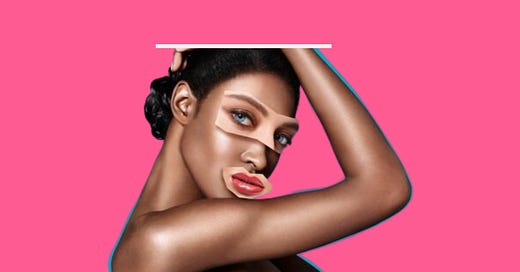In today’s post:
Q (not) A Beauty & Pop Culture Questions
The Full Beat Glow Up Regret Is In: Why is sharing "botched" procedures always good content?1
Is it bimbocore, or the appropriation of Black & Brown women’s nail trends? It’s the second one. Bimbocore nails are trending and articles like this one link them broadly to the wave of Y2K trends. Like most writers reflecting on the time, Rodriguez fails to mention that extra long, bedazzled, and dramatic nails did not trend as widely across race/age/gender boundaries as hindsight would have us believe. Check out these articles about the Black women who shaped modern nail art trends and the long history of Chicana’s artistic expression through nail art.
Do you need to buy makeup from a video game? Like from inside the Roblox universe? Nope. Despite this obvious answer, e.l.f has set up a virtual kiosk to “disrupt shopping norms.” Obviously the primary targets for the kiosk are Gen Z players who may also be enticed by the e.l.f.'s humanitarian and entrepreneurial efforts. While this is lovely, the company’s goal is still to turn a profit, and the target customers are 13+ players interested in lip oils.
How impressive is Taraji P. Henson? Very. Because doing her own nails under the intense scrutiny of red carpet cameras and film set lights is very cool and very brave. She also has a fully functioning nail salon in her house which is just cool as hell.
In Face Down A*s Up I cited a growing disinterest in plump features, like lips and butts, among women who’d used their enhancements to leverage the attention and capital of their audiences. I wrote,
The Great Dissolve has been determined largely by white female celebrities who are dissolving their facial filler. In most instances, these women are denouncing fillers and sharing their regrets about ever having them injected in the first place. Amy Francombe describes the era as such, “...lately it seems like celebrities are now backtracking on their trigger-happy syringe habits, and are instead ushering us into the great de-puff.”
Now, the profitability of thinness has shifted the cosmetic aims of patients and the interest of social media. Enter what Laura Pitcher calls the “Glow Down Era.” Pitcher’s piece explores the creator's “glow up regrets” and their documentation of procedure reversals after a lifetime of trying to glow up (or, be prettier). Not unlike the Great Dissolve, the Glow Down era is an attempt to brand cosmetic changes to grow their audiences.
According to Pitcher there’s an obvious overlap between “glow-up” and “glow-down” content. We love watching drastic changes at the expense of others, and the videos reach millions of viewers.” And, we know that this kind of content is not new. So why is glow down/procedure regret content always trending?
In The Morbid Appeal Of “Botched” Plastic Surgery Terry Nguyen argues that “the botched body becomes a warning, a reminder of the unspoken standards we are held to.” Nguyen writes that seeing a body “disfigured” after attempts to perfect it reflect our social anxieties about
the advancement of biological science and Western medicine,
the perceived loss of agency over our bodies, [and]
algorithm-influenced beauty standards, or bodies that fall outside societal norms.
Nguyen cites to fictional examples of our collective interest in “bodies-gone-wrong,” using Frankenstein, The Fly, and Eyes Without A Face. Each example exaggerates the consequences trying to wield power over the human form. Per Nguyen’s examples, no good can come from such attempts, hence the significance of shows like Botched. Beauty standards have always changed rapidly, so have (1) the punishments for failing to meet those standards and (2) the punishments for trying to perfect ones body.
In The Virtues of Fat Suffering I asked why losing weight must appear difficult to audiences, if it's to be celebrated? The act of celebrating weight loss is another post/newsletter entirely. I was curious about why those on weight loss medication were being judged for not having gone through a difficult or strenuous process? And, why is there an expectation that fat people stop being fat, in a publicly challenging way?
I identified two pillars of beauty standards, (1) Performance Prerequisite and (2) Penance Party. Performance Prerequisite refers to the act of changing one’s appearance in demanding detailed skincare routines, sweaty gym videos, or homemade dressing for neatly portioned salmon salads. Penance Party is the belief that whatever we dislike about ourselves is an unfair punishment to those around us.
“These two points circle each other like moons and have contributed to the audience's expectation that the subject is sorry for ever being fat (i.e. Not Attractive) and that they will publicly display their efforts to “fix” themselves.”
Regretful glow down videos illuminate both pillars perfectly. In each instance the Creator/Subject of the video publicly shares the details of their attempts to perfect themselves via a glow up. Creator/Subject also publicly details why this was a mistake and how the consequence, cosmetic failure, is a burden they are sorry about. I don’t foresee an end to the glow down or de-puff content, especially with the influx of black market beauty products and enhancements.



